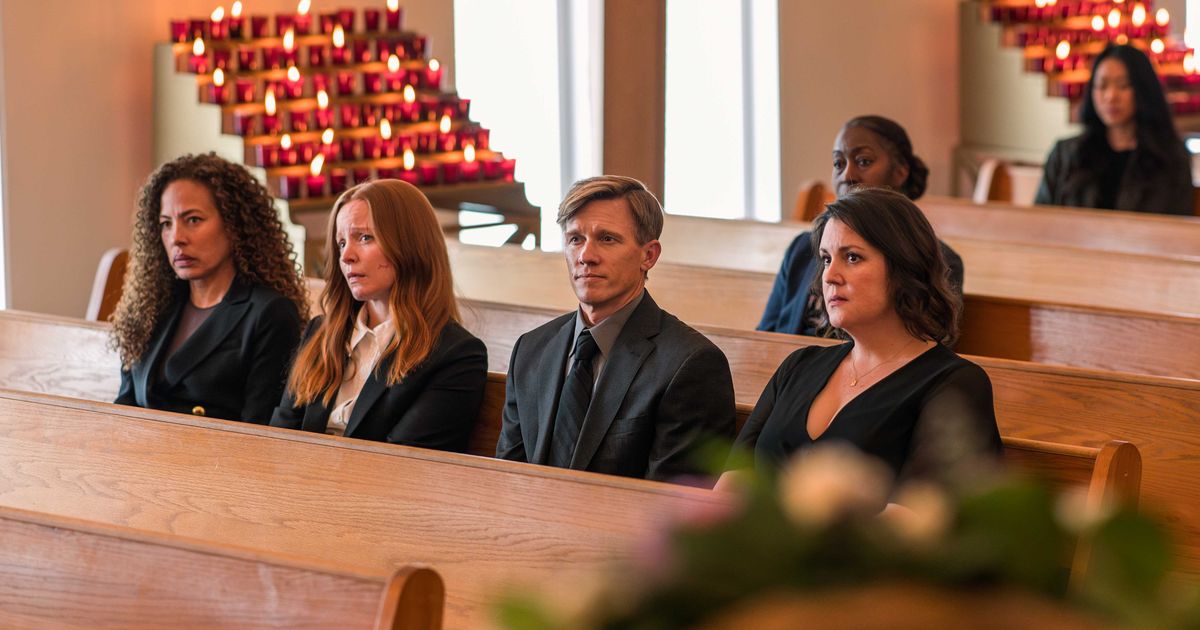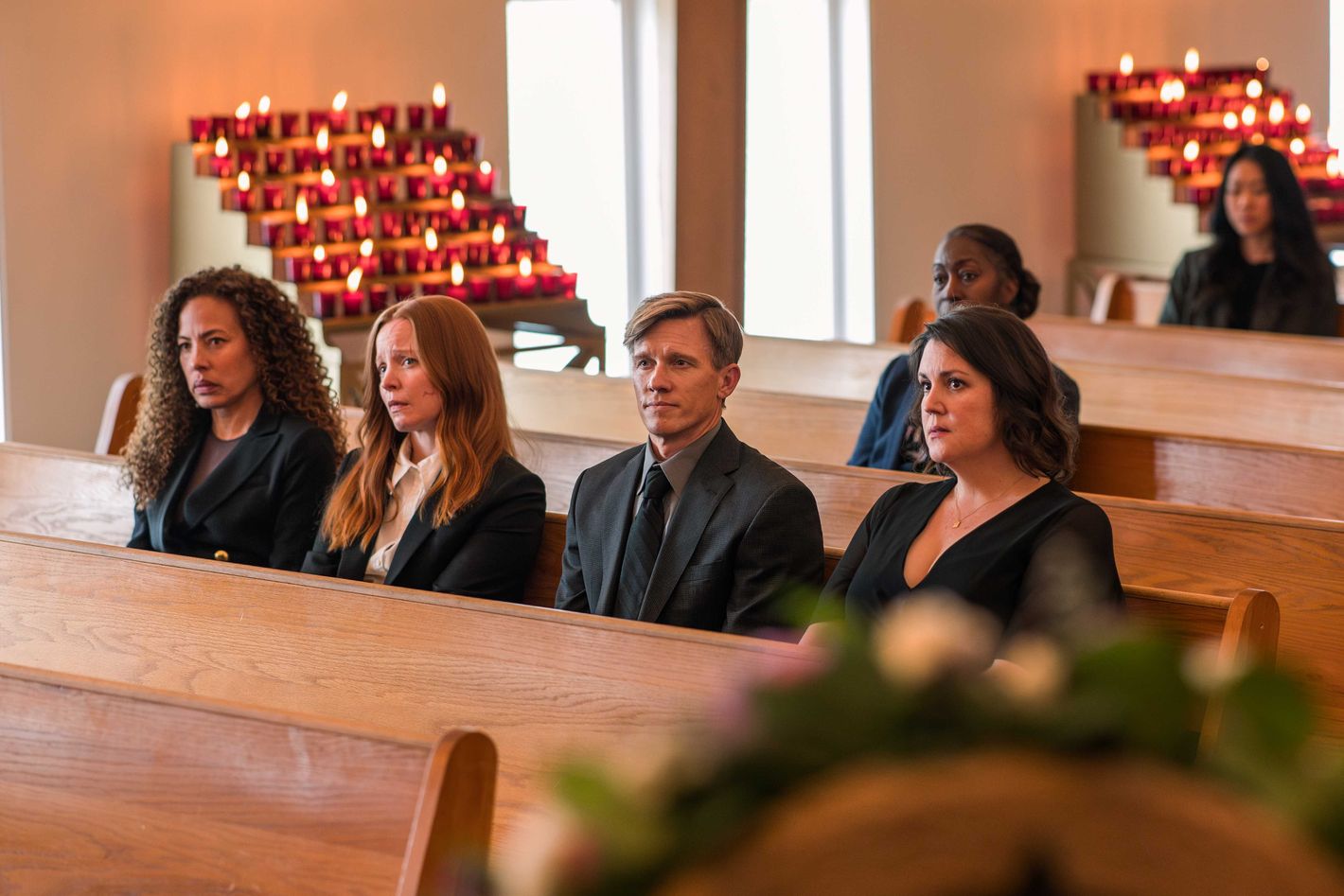Subsisting on Scraps
Yellowjackets saves the juiciest meat for its ’90s story line, leaving characters in the present day starved for attention.


More and more, the experience of watching Yellowjackets is like going to one of those all-you-can-eat meat buffets, the kind where servers walk around with skewers of glistening, buttery, bloody flesh and slide pieces across your plate. What succulence! What gluttony! All your favorite cuts brought right to your table! Then, after you savor those first few bites but still crave more, you can’t track down another server. You wait, but you’re being fed less. You fill up on bread and pick through the salad bar with the growing feeling that most of the good stuff walked away from you before the end of the meal.
From the moment its girls’ high-school soccer team crash-landed in the Canadian wilderness, Yellowjackets has explored how American culture, broadly and flatly patriarchal and conservative, denies women’s appetites — then punishes them when they explode with desire. Three seasons in, this approach remains incisive in the ’90s story line, especially when combined with spooky world-building and supernatural imagination. In retaining an “Is it real or is it trauma?” squishiness, Yellowjackets’s survivalist portion provides more definitive and immediate thrills in how its characters hook up, chow down, and keep house. But after season two lost its way narratively with the adult versions of our favorite cannibals, season three threatens even more of that imbalance, cutting off various present-day plots as if admitting its characters’ drastic-measures adolescence is more captivating than their mystically ambiguous adulthood. This is already an aspect of the series’ plotting, with Shauna’s resentment at ending up a housewife and Misty’s closest friend being her pet parrot, but it shouldn’t be the meta text. Yet season three feels like Yellowjackets wiping the board of its adult story lines rather than working them out of the corners they’ve been written into.
The season premiere, “It Girl,” jumps both timelines forward. In the past, reigning Antler Queen Natalie’s difficulty in keeping the group’s various factions together is helpful hindsight context for her adult misery but also makes Juliette Lewis’s absence in the modern timeline that much more noticeable — and the disorienting agony she brought to the role that much more missed. Yellowjackets presents her funeral, six weeks after the events of “Storytelling,” as the end of the story for both her and the late adult Travis (whom none of the other Yellowjackets seemed to care that much about) and a path forward for Shauna, Misty, Van, and Tai to move on with their comparatively more stable lives.
The series has always been skillful at swerving its characters away from expected conclusions and letting them chase down their hunches, intuitions, and anxieties wherever they may go. But that approach results in the characters feeling siloed when season three begins. Natalie is gone, Shauna’s murder of Adam has been blamed on someone else, and Misty’s relationship with the nebulously motivated Walter has gotten more serious. In its haste to move on from adult Natalie’s influence on the story, Yellowjackets glosses over the women’s complicated relationship to grief, using her demise as a tool to ratchet up the series’ eerie tone rather than a way to meaningfully explore what happens when this group loses a core member at this stage of life. And while it’s admirable to try to serve the sprawling cast by providing separate arcs for Melanie Lynskey, Christina Ricci, Lauren Ambrose, and Tawny Cypress, Yellowjackets forgets that a major appeal of this ensemble is what its members get up to together.
The acting isn’t the issue. Lynskey and Ricci are still exceptional; a fight in the third episode, “Them’s the Brakes,” requires both to be hilariously outsize in their disgust with each other while revealing how deeply the wounds from their ordeal run. It’s one of the season’s best early scenes for how fully it lets the actresses dig into their irritation and isolation. Other characters’ decision-making, though, feels less like a natural next step and more like the story needs them to get somewhere they otherwise wouldn’t go. This applies most consistently to Shauna and Jeff’s daughter, Callie, who is this season’s MVP for nonsensical decision-making, especially when a shocking turn at the end of the fourth episode, “12 Angry Girls and 1 Drunk Travis,” adds to the growing narrative asymmetry.
Back in the past, the season opens on what seems like another girl-on-girl hunt but is actually a vicious spin on “capture the flag” set during the tawny-gold-russet-mossy-olive days of spring. (We still haven’t seen a full version of the ambush that opens the series, so maybe that’s next winter?) The snow is gone, temperatures are rising, and the survivors have settled into a community not unlike a nature reserve that recalls the folk horrors of The Wicker Man and Apostle. The group’s loudest wilderness worshippers increasingly enforce a culture of religious conformity, and these expectations steadily divide the survivors as they confront the accumulation of their lost months. Sure, there are cute ducks waddling around the encampment, but the groaning wind, dense forest, and unyielding mountains summon the series’ long-standing specter of pagan mysticism, as if the area were ruled by old gods who see the Wiskayok high-schoolers not as survivors but trespassers. You’re going to have to suspend your disbelief for some of the teens’ accomplishments, like crafting wooden furniture and illuminating sky lanterns, but otherwise the woven-rattan teepees, animal-hide capes, and feather-and-flower headdresses suggest an increased resourcefulness under Natalie’s Antler Queen leadership.
Heavy is the crown, though, and Natalie’s classmates’ breaking off into pairs makes her feel lonelier than ever following her breakup with Travis. Van and Taissa are deeply in love, even as their opinions about the mysterious entity they’ve taken to calling “It” aren’t quite aligned. (This is the opposite of how they’ll feel as adults, in a tense subplot that is somewhat moved forward in the present day.) Lottie is using the group’s growing knowledge of the area’s plant life to ply Travis with psilocybin mushrooms; she’s sure that when he’s tripping, experiencing his surroundings as undulating, multicolored landscapes, he’s actually communicating with “It.” Purposely reaching out to the unknown forces around them is familiar, and reckless, behavior on Lottie’s part, and it’s surprising that the others seem fine with this experimentation on one of their own.
Most compellingly, Shauna has grown bitchy and maniacal following her baby’s death and Natalie’s ascent to leadership. Her hatred of the group’s growing paganism instills in her an unspoken power that basically allows her to do whatever she wants, from sneering at Van’s religious ceremonies to swaying group votes in her favor. The only vulnerability she briefly shows is with Melissa, a survivor introduced in season two, who Shauna is surprised to learn “actually has a personality.” The venomous Sophie Nélisse and adoring Jenna Burgess make an unlikely duo that conjures the intimate, complicated relationship between Shauna and her former BFF, Jackie, and further underscores how much of Shauna’s soft-spoken, mild-mannered adult self is a blunted version of her youth. On top of all this interpersonal drama, the trees, which evoke David Lynch’s many lingering shots of Twin Peaks’s ominous forests, are possibly sentient, and the landscape itself may be poisoning everyone’s minds. A recurring, cacophonous sound mixes human screams, snarling growls, grinding gears, and industrial churn. Fun!
There is still nourishment in Yellowjackets: in the disturbing new villains emerging from — and the power struggles occurring within — the wilderness; in Lynskey’s nailing a brutally caustic speech; in the creative verve with which the writers wink at the existence of this series as a work of television. When co-creators Ashley Lyle and Bart Nickerson and the rest of their creative team home in on what makes these girls and women tick, maneuvering the characters to reflect the thin line between civility and the feral, Yellowjackets is luscious, immersive, and barbed. Rare is the series that so fully has its dopamine-hit formula down, and its yesteryear needle drops (a Rancid–Cat Stevens is a one-two punch after my own heart) and characters’ telling men they suck (Ricci’s Misty drunkenly trying to light a man’s crotch on fire, also after my own heart) are as intoxicating as ever. But the impenetrability of where this story is going, and the dwindling numbers of who will survive by the end of it, are diminishing shadows that glow.








